Was
he a Nazi or was he a scientist?
Most would like to believe the
later, although many feel von
Braun was indirectly responsible
for the deaths of thousands.
German-born American rocket
scientist and “space architect”
who served both Adolf Hitler and
American presidents with his
unique ability to promote and
develop rocket technology. Even
if one feels his actions (or
in-actions) towards slave labor
were reprehensible, the fact
remains that Wernher von Braun
was responsible for the space
age becoming a reality in this
century. Von Braun was named by
Life magazine as one of the "100
Most Important Americans of the
20th Century," touting him as
the man who "launched the
greatest adventure of all, a
journey to the Moon" But, others
would ask—at what cost?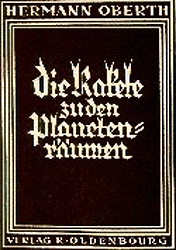
Wernher Magnus
Maximilian von Braun was born
to Baron Magnus von Braun and
Emmy von Quistorp on March 23,
1912, in Wirsitz, a town in
the eastern German province of
Posen. Wernher's father was a
wealthy farmer and a
provincial councilor and
served as Minister for
Agriculture during the 1930s
in President Hindenburg's
Weimar Republic. From
childhood, Wernher revealed an
interest in both science and
music. At age 11 he enrolled
in the Französisches Gymnasium
that had been established two
centuries earlier by Fredrick
the Great. There, the boy
showed only a modest ability
in mathematics and physics,
subjects in which he would
later excel. In 1928 Wernher's
father placed him in the
progressive Hermann Lietz
schools. Wernher's grades and
abilities improved. Hermann
Oberth’s book, Die Rakete zu
den Planetenräumen (The Rocket
into Planetary Space) captured
the young boy's attention.
However, von Braun soon
learned that he would have to
excel in mathematics to even
understand the concepts and
principles in the book.
Even during these younger
years of his life, von Braun
was experimenting with rockets
and propulsion. He once
strapped a cluster of solid
rocket motors to a wagon and
shot it down a crowded street.
Many in the crowd were not
amused.
“I was
ecstatic,” von Braun later
recalled. “The wagon was
wholly out of control and
trailing a comet’s tail of
fire, but my rockets were
performing beyond my wildest
dreams.” The fire-breathing
wagon diverged onto the
Tiergarten Strasse, a very
crowded Berlin city street. An
angry police officer grabbed
the young rabble-rouser and
threatened to arrest him.
“Fortunately, no one had been
injured, so I was released in
charge of my father.” —Erik
Bergaust, Reaching for the
Stars, 1960
Audio: Von Braun
describes his youth and
fasination with Oberth's
book
Audio: Von Braun
speaks about
apprenticeship under
Oberth
The next step for the
eighteen-year-old Wernher von
Braun was to enter the
Technische Hochschule in the
Berlin district of
Charlottenburg. All the while,
his interest in astronomy and
space travel kept growing. He
had become acquainted with
astronautics pioneer Hermann
Oberth, writer and spaceflight
promoter Willy Ley, and rocket
experimenters Rudolf Nebel and
Johannes Winkler. He has also
followed the exploits of Max
Valier who had gained publicity
driving autos and rail cars
powered by solid-fuel rockets.
Von Braun quickly joined the
Verein für Raumschiffahrt (VfR,
Society of Space Travel) and was
soon participating in rocket
experiments at the
Raketenflugplatz located on a
vacant Army proving ground near
Reinickendorf. —Frederick I.
Ordway & Mitchell Sharpe,
The Rocket Team, 1979
After
they were invited to watch a
rocket demonstration, members
of the Army Reichswehr at Army
Ordinance failed to be
impressed with anyone or
anything other than the young
Wernher von Braun. The VfR
members had hoped to gain
funding from the Army to
continue their experiments,
but it was 1932 and Adolf
Hitler was in power. Nazi
Germany was going to ban all
rocketry experiments and
discussion - outside of the
German military.
On
November 1, 1932, von Braun
signed a contract with the
Reichswehr to conduct research
leading to the development of
rockets as military weapons.
In this capacity, he would
work for Captain Walter
Dornberger. His association
with Dornberger would last for
over a decade. In the same
year, under an Army grant, von
Braun enrolled at the
Friedrich-Wilhelm-Universität
from where he graduated two
years later with a Ph.D. in
physics. His
dissertation dealt with the
theoretical and practical
problems of liquid propellant
rocket engines. Even
before he graduated, von Braun
was busy conducting his first
rocket tests at Kummersdorf,
an old Army artillery range
outside of Berlin. A few of
von Braun's colleagues from
the VfR days joined him and
started work on what would be
called the A1 rocket. The A1
would eventually evolve into
the A2 and A3. These rockets
were successfully tested off
the coast of Germany in the
North Sea. —Frederick
I. Ordway &
Mitchell Sharpe, The
Rocket Team, 1979
By, 1935, von
Braun and his team,
which had grown to
eighty members, were
regularly firing
liquid-fueled engines
with great success. The
operation was
out-growing the
facilities at
Kummersdorf. A
secure, isolated location was
suggested by Wernher's mother.
It was called Peenemünde. This
wooded, quiet part of Germany
was located on the Baltic Sea
at the mouth of the river
Peene on the island of Usedom.
The Army and the Luftwaffe
poured money into the
co-development of Peenemünde.
A huge complex of buildings
for housing, testing,
manufacturing and development
were constructed. The site
would eventually be home to
over 2,000 scientists and
4,000 other personnel. —Christopher
Lampton, Wernher von Braun,
1988
Audio: Von
Braun describes early
experiments and
Reinickendorf and
Kummersdorf
The
Peenemünde complex began work
on the military weapon, the
A-4, with von Braun in charge
of technical development.
After several tries, an A-4
missile was successfully
launched on October 3, 1942.
Much was still unfinished
though - a successful launch
did not translate into a
proven weapon system. It would
be two years later that the
first A-4/V-2s were
operationally deployed.
During
these fast-moving early
development stages of
Peenemünde's growth, the
multitude of German scientists
and engineers were well served
by the young and resourceful
von Braun. His ability to put
the right personnel in key
positions, the ability to
streamline research efforts,
head off disputes, secure
materials and von Braun's own
exuberance for the A-4 project
was key in Peenemünde's
success.
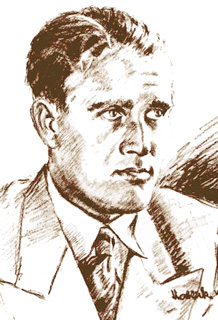 |
Less than a year after
the first A-4 success,
the British became
suspicious of the goings
on at Peenemünde. In
mid-August 1943,
hundreds of RAF bombers
attacked the site
causing damage. The
facilities could be
repaired but, it was
decided that full
production of the
A-4/V-2 would have to be
moved to a more secure
location, away from
other potential bomber
attacks. Peenemünde
would remain as a
research center for
improved missile designs
and Luftwaffe jet
powered aircraft. Von
Braun was to remain at
Peenemünde in charge of
testing.
A
frightful event occurred
in mid-March 1944 when
von Braun was arrested
by the Gestapo and
imprisoned in Stettin.
The alleged crime was
that von Braun had
declared his main
interest in developing
the A-4/V-2 was for
space travel—not as a
weapon. Also, since von
Braun was a pilot, who
regularly piloted his
government-provided
airplane, it was
suggested that he was
planning to escape with
A-4/V-2 secrets to the
Allies.
It was the
personal intervention of
Munitions and Armaments
Minister Albert Speer
with Hitler that gained
von Braun's release from
jail. It had only been a
few weeks earlier that
von Braun refused an
offer from Reichsführer
SS Heinrich Himmler.
Himmler had proposed
that von Braun should
leave the German Army
rocket program and come
to work for the SS. It
is believed that Himmler
was directly responsible
for von Braun’s arrest.
—Michael Neufeld, The
Rocket and the Reich,
1995 |
Von Braun had accepted a
position of rank in the SS
when it was offered to him a
few years earlier. Later, von
Braun would say that he
accepted it only out of
necessity and that he only
wore the uniform on one
occasion. While his statement
may be somewhat true, this
does show that von Braun was
willing to compromise much to
keep the research ongoing.

Photos below show on
Braun's early years and wartime
images.
(CLICK ON
THUMBNAIL TO ENLARGE)

In
1943, Reichsführer SS Heinrich
Himmler forced component
manufacturing, missile
assembly and military
deployment of the A-4/V-2 out
of the hands of Dornberger and
von Braun who wanted to
continue improving and testing
the rocket before releasing it
for production. The
underground factory called the
Mittelwerk, in central
Germany, began producing
A-4/V-2 rockets late that year
along with other weapons such
as the Fi103 or V-1 flying
bomb. Several thousand workers
from nearby concentration
camps, together with thousands
of civilian workers began
producing weapons. Even after
production had begun on the
missile, the V-2 systems were
not completely ready for mass
production. Almost another
year of testing was needed to
make the weapon reliable.
Beginning in September of
1944, the A-4s—now called
V-2s—were launched against
Paris, London, Antwerp, and
other targets.
As
the Russian Army closed in
on Peenemünde from the east
in 1945, it became apparent
to Wernher von Braun and his
staff that things were
coming to an end at the
research center. Von Braun's
staff was now under the
direct command of the SS,
Hitler's elite army, and von
Braun feared that SS General
Hans Kammler might possibly
use the scientists as a
bargaining chip or have the
scientists killed to keep
them from being captured by
the Allies.
Von
Braun had received several
contradictory orders from
German High Command which
was in mass confusion at the
time. As von Braun later
stated, "I had ten orders on
my desk. Five promised death
by firing squad if we moved,
and five said I'd be shot if
we didn't move." Since he
was damned either way, von
Braun called a meeting in
mid-January 1945 with the
other top officials at
Peenemünde. The rumor was
the Russians were
approaching fast from the
south and that the path of
escape might be closed soon.
If the scientists and
engineers remained at
Peenemünde, they would
either be killed in combat
or taken prisoner by the
Russians. They certainly did
not like either of those
prospects.
They
all decided they wanted to
surrender to the Americans.
If nothing else, they were
more likely to be able to
continue their research
after the war in the United
States. They knew that
somehow they had to smuggle
all their research papers
and important equipment out
of Peenemünde. They
certainly could not allow a
decade's worth of work to be
destroyed or fall into the
wrong hands again.
As
the Third Reich collapsed,
there was no chance that
Peenemünde would be saved.
That is why von Braun was
utterly amazed when he
received an order from the
local army defense commander
to become soldiers and fight
the Russians when they
arrived at Peenemünde. This
would almost guarantee their
demise. But another set of
orders came from General
Kammler stating that the
engineers and scientists
were to move to central
Germany, close to the
Mittelwerk factory. Von
Braun was still wary of
Kammler's real intentions.
Kammler might be moving the
scientists to a location
where he would have the
ability to turn them, along
with the technology at the
underground Mittelwerk, into
hostages. However, von Braun
knew it was the best option
for their continued freedom.
Von
Braun prepared to evacuate
thousands of engineers,
scientists and their
families to central Germany.
It was a tremendous task,
but von Braun insisted that
it be done in an orderly
fashion. He was the
consummate leader at this
time also. For ten years he
had demonstrated his
leadership abilities with
staff, technical problems,
and in dealing with
politicians—but this move
south really showed the
determination of von Braun.
German command and society
was crumbling all around
them, yet somehow the
organization held together.
They
went to work rapidly. Almost
all of the coordination went
through von Braun's close
staff. Simple things such as
procuring boxes became a
daunting task at this point
in the war. They invented a
color-coding system to make
it easier to identify the
contents of what they were
moving. A convoy was
organized, in which
thousands of workers,
engineers, and other
Peenemünde support personnel
would be transported by
train, truck, car, and any
method available. Moving
this many people was bound
to draw attention. Von Braun
knew he would be questioned
about the move by local
authorities. As luck would
have it, a recent shipment
of stationary from the SS,
that identified Peenemünde
personnel as a branch of the
SS, was badly mangled at the
printer. The letterhead was
supposed to read BZBV Heer,
the name of an organization
within the SS. Instead, it
read VABV, in initials of a
nonexistent organization.
Von Braun's staff quickly
invented a top-secret agency
with the initials VABV,
translated in English
meaning Project for Special
Dispositions.
The
initials VABV were painted
and marked on boxes,
vehicles, and armbands,
anything that might be
checked by SS inspectors or
other authorities. All of
the material and equipment
was then packed into trucks
and cars. The convoy headed
south and along the way SS
agents stopped the caravan
frequently, but the VABV
deception worked and they
were allowed to continue.
Later, they received word
that Peenemünde had been
captured by the Russians. A
few weeks after that, the
Americans captured the
Mittelwerk. General Kammler
ordered von Braun and 500 of
the top scientists to be
separated from their
families and moved to the
village of Oberammergau.
They were placed in a small
internment camp that was, in
von Braun's words,
"extremely plush, not
withstanding the barbed-wire
around it." Kammler was
indeed holding the
scientists hostage. They
were surrounded by SS guards
constantly. One day von
Braun pointed out to the
head of the SS guard that
the Oberammergau camp could
be easily bombed by Allied
aircraft. One attack could
wipe out all of the Third
Reich's top rocket
scientists. Any guard that
allowed that to happen would
surely be shot.
The
guard agreed and let the
scientists out of the camp
and into the streets of
Oberammergau. He also agreed
to let the scientists dress
in civilian clothing so
American troops would not
suspect that they were of
any importance. Von Braun
quickly arranged for
vehicles from Bleicherode to
come get the scientists.
They were really free at
this point. Now all they had
to do was surrender to the
Americans.
On
March 15, 1945, midnight, a
young civilian was
chauffeuring von Braun in a
Hanomag truck from
Bleicherode to Naumburg,
then driving on the
Autobahn, with the
destination being Berlin.
Both fell asleep and the car
left the roadway. A few
hours later the car was
spotted by Peenemünde
associates Hannes Lührsen
and Bernard Tessmann, who
were also traveling to
Berlin. Lührsen stayed with
the injured while Tessmann
drove for help. Von Braun
suffered a broken arm and
fractured shoulder. He awoke
to find himself in a
hospital bed. Even though he
was in no condition to be up
and moving around, von Braun
insisted that his arm be set
in a cast so he could leave
the hospital.
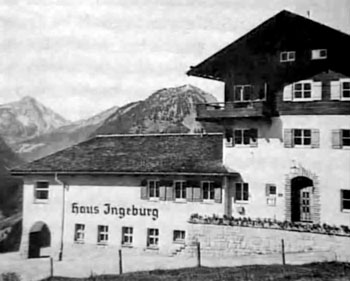 Patton's army was still far
away. The meager supply of
fuel available to the Allied
columns was slowing the
advance of the Americans.
Needing food and supplies,
the rocket scientists again
used the VABV ruse to
requisition the items from
German Army supply posts.
The scientists then moved to
the resort hotel, Haus
Ingeborg, in the border town
of Oberjoch, near Austria.
There von Braun met up with
General Dornberger from
Peenemünde. Von Braun's
brother Magnus was also
there.
Patton's army was still far
away. The meager supply of
fuel available to the Allied
columns was slowing the
advance of the Americans.
Needing food and supplies,
the rocket scientists again
used the VABV ruse to
requisition the items from
German Army supply posts.
The scientists then moved to
the resort hotel, Haus
Ingeborg, in the border town
of Oberjoch, near Austria.
There von Braun met up with
General Dornberger from
Peenemünde. Von Braun's
brother Magnus was also
there.
There
was not much to do except
wait for the Americans. The
scientists played cards and
listen to the radio. They
heard of the fall of Berlin
on May 1, 1945, along with
the news that Hitler was
dead. As the Americans
finally drew near, it was
decided that Wernher von
Braun's brother, Magnus,
would go out to greet the
troops and surrender for
everyone. The reasoning for
this was that Magnus could
speak broken English and it
was thought that a large
group of German men marching
toward the Americans would
seem hostile or threatening.
Young
Magnus pedaled off on a
bicycle to meet the
Americans. The first soldier
that he encountered was a
sentry with the 324th
Infantry Regiment, 44th
Infantry Division, PFC
Frederick Schneikert. Magnus
was ordered to drop the
bicycle and come forth with
his hands up. In a
smattering of English mixed
with bits of German, Magnus
tried to explain his
mission. The young American
soldier was not really sure
what to do with this boyish
figure claiming to be a
rocket scientist, so he
turned the matter over to
his commanding officer,
First Lieutenant Charles L.
Stewart. Stewart at first
thought that Magnus was
trying to "sell" his brother
and the other scientists to
the Americans. The
communications were soon
cleared up and Lieutenant
Stewart gave Magnus passes
for the Germans, to ensure
their safe passage to the
American encampment.
Audio:
Wernher von Braun
describes the evacuation
of Peenemünde
Wernher von Braun, General
Dornberger, and several
other scientists were so
excited after Magnus
returned that they piled
into three vehicles and
immediately headed for the
American camp. The Americans
were struck by Wernher von
Braun’s young good looks and
his charm. He did not look
the part. He did not
resemble the imagined image
of a top German rocket
scientist. The Americans
soon realized the importance
of their prize. Reporters
and newspapers flooded in to
see the rocket scientists.
When
the Americans questioned the
German scientists about
their advancements in
rocketry and propulsion,
they stared back at their
interrogators in
bewilderment. “We were only
expanding on the work of the
American scientist Robert
Goddard, why haven’t you
asked him about rocketry?” A
few months later, von Braun
and the other scientists
would sign a contract to
come to America and detail
their work to the U.S. Army
at White Sands—just what
they wanted all along. It
would be a new phase of von
Braun's life, one that would
climax with man
walking on the moon.
During the summer of 1945,
interrogation by the Allies
continued. The Americans soon
offered von Braun and some 120
key members of his team a
six-month contract to work for
Army Ordnance in the United
States. The offer was
accepted. Soon von Braun and
six colleagues were on their
way to the United States.
After briefings in Washington,
D.C., they were sent to Fort
Bliss near El Paso, Texas. Six
months later, many more
Peenemünde scientists were
sent to the U.S. to join
them.
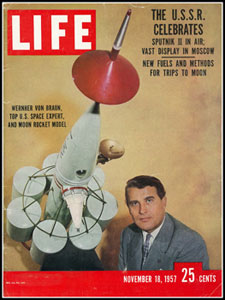 It
was at the new U.S. missile
proving grounds in White
Sands, New Mexico that von
Braun set about training and
testing rockets for the U.S.
military. For the next five
years hundreds of captured
V-2s were sent skyward
carrying a multitude of
payloads. Von Braun and his
men were transferred to
Huntsville, Alabama in April
of 1950 to start development
of an Army tactical ballistic
battlefield missile. At the
Redstone Arsenal, von Braun
helped develop the Redstone
missile.
It
was at the new U.S. missile
proving grounds in White
Sands, New Mexico that von
Braun set about training and
testing rockets for the U.S.
military. For the next five
years hundreds of captured
V-2s were sent skyward
carrying a multitude of
payloads. Von Braun and his
men were transferred to
Huntsville, Alabama in April
of 1950 to start development
of an Army tactical ballistic
battlefield missile. At the
Redstone Arsenal, von Braun
helped develop the Redstone
missile.
It
was in Alabama that the
Germans eventually gained
their American citizenship.
Soon, the space race with the
Soviet Union created an urgent
need for von Braun's help.
America's first satellite was
launched from a Wernher von
Braun design, the
Redstone-based Jupiter-C.
In the Fifties
von Braun started
writing for science and
cultural magazines with his
vision for manned
space programs. In the
winter
of 1952 he wrote
a series of
articles for the
popular magazine
Collier’s. For
those Collier’s
reports, von Braun
stressed the
importance of
“establishing a
‘node’ in low
Earth orbit,” and
so first
introduced the
modern version of
a space station
and many other
technical aspects
of space flight
that later became
a reality. For
instance, von
Braun wrote in Collier’s Magazine from March 1952
that the space
station would be
constructed using
rockets with
recoverable and
reusable ascent
stages, with a
“toroid
structure." Along
with Willy Ley,
von Braun has been
called the Einstein
of rocket and
space technology
after writing that
man will venture
into space with "spinning
space stations,
lunar landings and
culminating in a
massive expedition
to Mars."
Von Braun
wrote that the
space station that
he was dreaming of
and planning would
be "an
assembly point for
expeditions to the
Moon and Mars," his
goal. He
also wrote that
it’s much more
economically sound
to launch his
rockets from Earth
orbit than "from
a deep potential
well,” since
he viewed an
orbiting station
as having an
obvious advantage
as "a
fuel depot and starting
point."
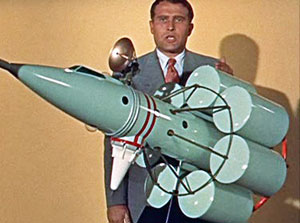 Von
Braun was called
“instrumental,” by NASA
history, in the
development of the U.S.
Space & Rocket
Center in Huntsville,
Alabama. There he helped
develop the Saturn V
rockets—his visionary
rocket, the Saturn 5—
that carried man to the
Moon. On March 1, 1970,
von Braun and his family
relocated to Washington,
D.C., where he was given
another top space job of
being NASA’s Deputy
Associate Administrator
for Planning at NASA
Headquarters. But, after
a series of conflicts
termination associated
with the of the his
favorite Apollo program,
he retired from NASA on
May 26, 1972. Wernher
von Braun died of cancer
at the age of 65 on June
16, 1977, in Alexandria,
Virginia. He is buried
in a small grave at the
Ivy Hill Cemetery in
Alexandria.
Von
Braun was called
“instrumental,” by NASA
history, in the
development of the U.S.
Space & Rocket
Center in Huntsville,
Alabama. There he helped
develop the Saturn V
rockets—his visionary
rocket, the Saturn 5—
that carried man to the
Moon. On March 1, 1970,
von Braun and his family
relocated to Washington,
D.C., where he was given
another top space job of
being NASA’s Deputy
Associate Administrator
for Planning at NASA
Headquarters. But, after
a series of conflicts
termination associated
with the of the his
favorite Apollo program,
he retired from NASA on
May 26, 1972. Wernher
von Braun died of cancer
at the age of 65 on June
16, 1977, in Alexandria,
Virginia. He is buried
in a small grave at the
Ivy Hill Cemetery in
Alexandria.
Recently,
some critics have made a
moral judgment and
implicated von Braun with
the use of slave labor. Many
believe that von Braun should not
have been celebrated as a hero.
They feel he turned a blind-eye toward
what was happening to slave
laborers in Germany—as
if, ridiculously,
he could have refused to
continue his work on the
V-2 for Himmler
and the SS unless this
practice was ended. This was
not an option, for it would
have lead to his own persecution. Whether
or not von Braun felt
compassion over the abuses
suffered by the slave
laborers, he was in no
position to
negotiate the terms
of his service to the SS or
Hitler.
The slave laborers at
the underground
Mittelwerk factory
were also forced by
the SS to build V-1
flying bombs, jet
engines and various
anti-aircraft
missiles. Von Braun’s
V-2 missile made up
only a portion of the
factory’s production.
The Mittelwerk was
used for final
assembly of the
missiles, yet the
manufacturing of V-2
components (over
17,000 individual
parts) was spread out
all over German
industry.
Then again, there is not much
evidence in official records to
indicate that he was disturbed by
the use of slave labor. The means
through which his experimentation
could continue was the vehicle of
the Wehrmacht’s war machine.
Von
Braun’s work on the rocket was his
passion throughout his whole life,
not just during the war. His crime
was one of success through
available means or the greater
evil of complacency, which
infected so much of the German
population during World War 2.
Click
here to view War
Department documentation
concerning the transfer
of German
scientists to the United
States
|

